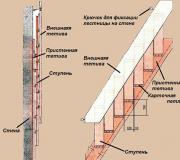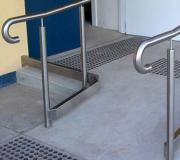Ramp for the disabled: dimensions according to GOST
In today's world, everyone has the right to free movement. In order to implement it, it is enough to make convenient entrances and approaches to all kinds of buildings.
Ramps do an excellent job with this task. However, it is not enough to do them right. Having said that there was enough for so many materials, or there was no more space. These are just excuses. If you do it, then it's right. And for this you need to know what a ramp for the disabled is, the dimensions of its parts and the requirements that it must meet.
What is a ramp, and what are its parts?
If you need to connect two horizontal surfaces that are located at different levels, then steps are installed between them. In situations where it is not physically possible to climb the stairs, it is replaced by a sloped plane. This design is called a ramp. When properly designed, it is able to provide easy and unhindered movement to the height of mechanisms with wheels.
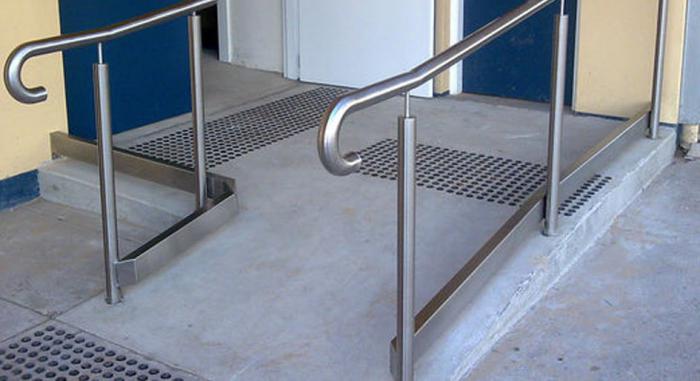
The design of the ramp, which meets the requirements of GOST, always consists of three parts. Each of them is mandatory and cannot be excluded.
So, the ramp is formed:
- from the level ground in front of him;
- sloped surface;
- and platforms in its upper part.
To get a comfortable ramp for the disabled, the dimensions of each of its elements must be strictly measured. Otherwise, it will be difficult or almost impossible to use them.
Types of ramp designs
Stationary ramp
It is installed in places where it is expected to be used for a long time. Usually this is the entrance to a building. Such structures may have one or more spans. Their number depends on the height of the stairs and the availability of free space in front of the entrance.
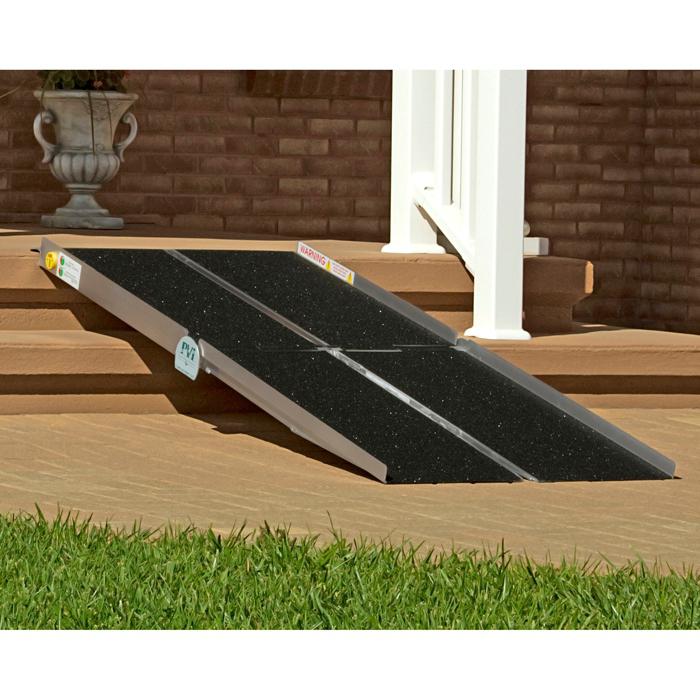
Folding ramp
This design is convenient in places where free space is limited. It has a special mount located on the wall or railing. As necessary, you can fold and disassemble the ramp for the disabled. The dimensions of the folding structure must be made such that it can be easily moved from a sitting position in a chair to a working position and back.
Removable ramp
This group of ramps, in turn, is divided into several types: roll ramps, ramps and sliding structures. The first of this list are small in size. In addition, their peculiarity is that they can be rolled up like a rug. Ramps are also small and are used to overcome low obstacles, such as curbs. A sliding or telescopic ramp extends from a hidden space and can be installed anywhere on the stairs.
Ramp area dimensions
Smooth horizontal surfaces must be present at the beginning and end of the structure. If the ramp is long or has turns, then there are more such sites. Then they will be placed at the end of each lift. Landings should not be narrower than the width of the ramp and very short. It must fit freely on them. Moreover, in this space it should be comfortable and turn around. Thus, a ramp for the disabled, the dimensions of which fit into the values: the width is twice its span, and the length is at least 1.5 m - it will be quite convenient. On it, you can safely remove your hands from the wheels and not risk rolling down.
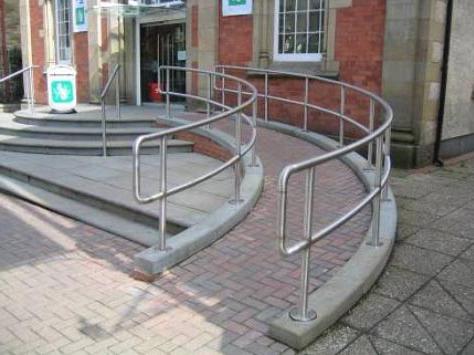
Construction width and length
They should be such that the wheelchair can easily fit on the ramp for the disabled. Dimensions - width and length - are clearly regulated by GOST. They differ for one-way and two-way designs. In the first case, the width must be at least 90 cm or 1 m. If the ramp provides for movement in two directions, then the width is doubled.
The maximum length of the lifting surface must not exceed 36 meters. Moreover, the length of one inclined section cannot be more than 9 m. This means that after this gap a turntable is needed.
Along the edges of inclined surfaces, bumpers are necessarily mounted. Their height must be at least 5 cm. They are necessary in order to prevent the wheelchair from slipping with a disabled person. Their absence is allowed only in cases where the ramp borders the wall or a solid handrail is fixed along its edge.
The angle of inclination of the ramp surface
The slope is calculated as a quotient in which the height of the ramp is divided by its length along the ground. It can be expressed as a percentage or in degrees. It can also be written as a ratio of two numbers.
This characteristic is the main one in the design. If the slope is small, then the ramp may turn out to be too long. And in the case of a very large angle, it will be impossible to enter it. Therefore, they need to be accurately calculated when a ramp for the disabled is still being designed. The dimensions according to GOST for the slope are limited by the maximum value, which is 5% (slightly less than 3º). The lifting height for this value should not exceed 80 cm.
In exceptional cases, an increase in slope up to 10% (slightly more than 5.5º) is allowed. Then the ramp is necessarily equipped with handrails. Because the independent lifting of a disabled person on it will be difficult.
If the ramp involves two-way traffic, then the maximum slope for it is 6.7%.

handrail requirements
The design is equipped with them without fail in the following cases:
- when the span height exceeds 15 cm;
- or the length of the inclined surface is more than 180 cm.
Handrails limit on both sides and along the entire length of the ramp for the disabled. Their sizes depend on who will rise more often: adults or children. The level of handrails is recommended to be double. The first is at a height of 60-70 cm, and the second is about 90 cm, for children the first value is reduced to 50 cm.
Other requirements for ramps
- A coating should be fixed on the inclined plane, which contributes to increased friction. This is necessary to reduce slip on the ramp.
- All parts of the structure should not interfere with pedestrians.
- If only one person will use a particular ramp for the disabled, the dimensions of the structure can be calculated individually for his wheelchair.
- The building material must not destroy the stairs.
- It is recommended to equip the ramp with special dampers to make its operation silent.
It is necessary to take into account all of the above points before you start installing the ramp.

